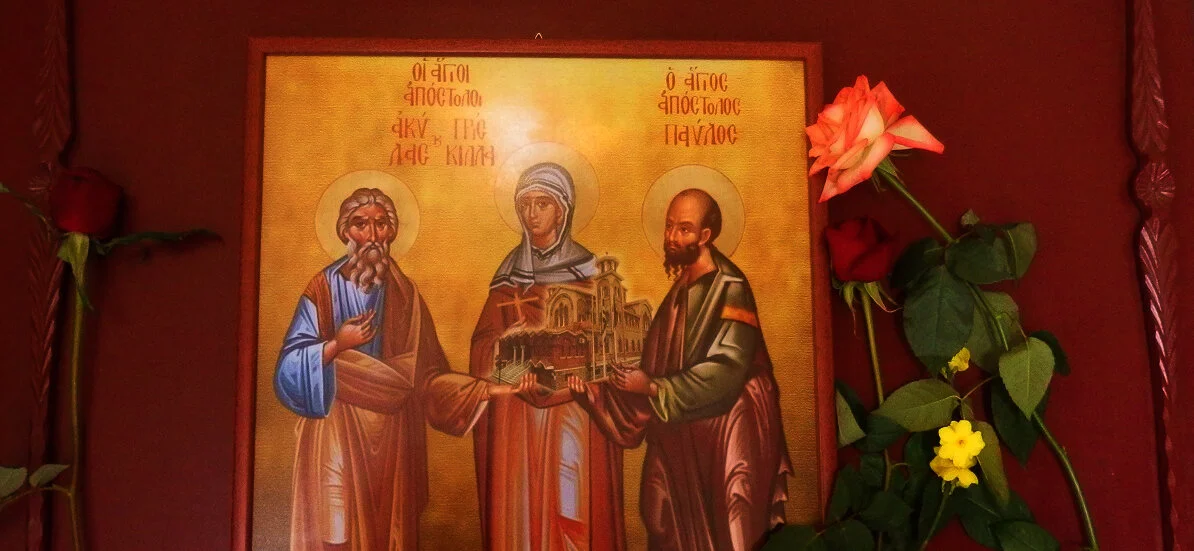by Fr Gabriel-Allan Boyd
Just a few days ago, July 8, two different people coincidently inquired of me as to why we emphasize so many monastic saints in the Church and why we rarely hear anything very tangible about married saints—those who’s asceticism (struggle) was centered upon guiding their family toward Christ’s likeness. It was ironic that two different people would ask me that same question on July 8, of all days, because in Russia, on that very day, they have a national holiday—a feast day—dedicated, especially, to honoring the virtue of Godly love, fidelity and family life, based on the lives of two married saints, named Peter and Fevronia. The truth is, we have a great many saints in the Orthodox Church who were married—like, for instance, Saint Basil’s parents and grandparents. So, it would indeed be helpful if we took more notice and inspiration from virtuous and self-sacrificially loving lives of our married saints, since—for the Orthodox Church—to faithfully live out a life of marriage and family is a Godly type of asceticism, leading to the kingdom of heaven. This week, on July 14, we also had another feast day celebrating a pair of married Saints from the book of Acts, named Priscilla and Aquila.
Priscilla and her husband Aquila were Jews, who while living in Rome, came to believe in Jesus as the long awaited-for Messiah. Back then, Jewish Christians didn’t think of themselves as different than any of the rest of the Jews. They just thought of themselves as Jews who believed in Jesus as the Messiah. So, they continued to attend the synagogues with the rest of their friends, and spent time there, trying to persuade other Jews about where the Hebrew Scriptures foretold of Jesus. As one might imagine, conventional Jews resented the presence of Jewish Christians in their midst, resulting in constant clashes between the two factions. The Roman Emperor Claudius eventually became exasperated by the ceaseless synagogue conflicts being reported to him and the chaos they caused in his city. Therefore, in 49 AD, he finally expelled all Jews (including Christian Jews) from Rome. Thus, Aquila and Priscilla, took this deportation as an opportunity to move their prosperous tent-making business to the thriving Greek city of Corinth. A year later, when Saint Paul (also a tentmaker) came to the city of Corinth on one of his missionary journeys, it was only natural that he would meet and develop a harmonious rapport with this enthusiastic Christian couple (Acts 18). The three hit it off wonderfully, proving to become fast friends, ministry coworkers, and even later traveling companions.
Accordingly, when it later came time for Saint Paul to move on toward missionary work in Ephesus, they accompanied him there. When Paul eventually moved on to go do missionary work in Antioch, Aquila & Priscilla remained in Ephesus for a while to help support the young church that had begun blossoming forth there. While in Ephesus, Priscilla and Aquila came across a persuasive orator named Apollos. He was going around, fervently teaching people about the Lord as had been taught to him by John the Baptist and was speaking boldly at the synagogue they attended. So, they quietly invited him to their home, to teach him more fully about the Good News of Jesus Christ, particularly about the difference between John the Baptist’s mere baptism of repentance...and the baptism of Christ, where one also receives the gift of the Holy Spirit (Acts 18:25-26). What an inspiring example we have here, of how this married couple simply utilized whatever resources that God gave them—their time, their home, their food, the things they’d learned from Saint Paul, their familiarity with the Hebrew Scriptures, etc.—to help Apollos more precisely bear-witness to the life-giving way of Jesus Christ. From that point on, using the Classical style of Hellenistic public debate that was very popular at that time, Apollos effectively refuted the Jewish scholars, using the Hebrew Scriptures to prove to them that Jesus is indeed their long awaited-for Messiah.
Later, when the Emperor Claudius’ expulsion of Jews from Rome was rescinded, we discover that Priscilla and Aquila returned to Rome (Romans 16:3-4). In his letter to the Church in Rome, Saint Paul, reminds the Church of the couple’s venerable place as his partners in ministry and as people who actually put their very own lives at risk for his sake. Imagine a married couple so committed to the spread of the Gospel that, together, they put their lives in harm’s way for Christ’s sake. In fact, Priscilla and Aquila offered their own house as one of the places where Christians in Rome could meet weekly to celebrate the liturgy together.
This saintly couple, Priscilla and Aquila, are mentioned by name in five places throughout the New Testament, and they were always cited together (Acts 18:2-3; Acts 18:18-19; Romans 16:3-5; 1st Corinthians 16:19; & 2nd Timothy 4:19). They offered much-needed leadership to the young parishes and were held in great admiration for their ever-present offering of themselves. Their partnership highlights a model of ministry that was found common in the early church (see Romans 16:7; & 1 Corinthians 9:5).
Their life together should bring to mind several things within symbolism and of the prayers of the Orthodox Wedding ceremony, revealing the purposes of Godly marriage. In one of the prayers of blessing that the priest prays over the couple, he asks God to, “Fill their houses with bountiful food, and with every good thing, so that they may have plenty to give to those who are in need, bestowing also on them that are here assembled with us all their prayers that are unto salvation.” In other words, the couple is blessed for the sheer purpose that they may offer God’s blessing to those who are in need in the world around them and that they may pray for the salvation of those around them. In one of the most significant symbols of an Orthodox marriage, the priest prays a blessing upon the couple that they may receive a crown of glory that does not fade away.” Then, a little bit later, the couple is crowned with glorious crowns like martyrs receive as our Lord’s reward—but these crowns are joined together with a ribbon, signifying that the husband and the wife are each supposed to offer their lives (dying to themselves) for the sake of the other...but also signifying that they are supposed to offer their lives (dying to themselves) together for the sake of the world. This tells the couple that their marriage is supposed to be a visible sign and a witness to everyone around them of the self-offering love of Jesus Christ. In other words, the world is supposed to experience their marriage as the actual presence of Jesus Christ. After they’re crowned, in the procession around the table (what’s referred to as “The Dance of Isaiah”), here’s one of the three hymns that’s sung, tying the couple intimately to the martyrs who have gone on before us to receive their crowns of glory: “O you holy Martyr Saints, who have fought the good fight, receive your crowns of victory, and intercede with Christ our Lord, to shine His tender His mercy on our souls.”
Through the prayers of Priscilla and Aquila who offered their lives together for the sake of the world, may the Godly asceticism of their relationship be an inspiration to us, pointing us to the kingdom of heaven, by uniting our marriages and the care of our families to Christ our God.



